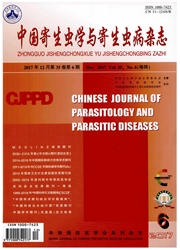

 中文摘要:
中文摘要:
目的观察日本血吸虫感染过程中Th2型免疫应答出现前后不同树突状细胞(DC)亚群、巨噬细胞、肥大细胞、嗜酸粒细胞和嗜碱粒细胞比例在小鼠脾中的变化。方法20条日本血吸虫尾蚴经腹部皮肤感染C57BL/6小鼠建立实验模型。在感染前和感染后2、4和6周处死小鼠,无菌分离小鼠脾,制备单细胞悬液。流式染色方法检测肥大细胞、嗜酸粒细胞和嗜碱粒细胞,并对DC和巨噬细胞进行分群,同时对其在脾非T非B细胞中的比例进行统计学分析。结果感染后4周,CD11C+CD8*DC在B220。DC中的比例从感染前的7.4%迅速增至17.1%:CD11c+CD4+DC从感染前的7.9%增至12.O%。从感染前到感染后6周,CD11e+CD4-CD8+DC在B220-DC中的比例基本保持恒定,维持在70%左右;浆细胞样DC(B220+CD11c+)在脾非T非B细胞中的比例呈现逐渐下降的趋势。感染后4周非T非B细胞中两群巨噬细胞(F4/80+CD11b^int,F4/80+CD11b恸)的比例(2.7%,8.6%)均明显低于感染前(15.4%,13.7%)。F4/80+细胞中高表达CD11b的巨噬细胞的比例从感染前47.1%增至感染后4周的75.5%。随着感染时间的延长,嗜酸粒细胞在小鼠脾中的比例逐渐增加,而嗜碱粒细胞和肥大细胞在脾中非T非B细胞中所占的比例却逐渐下降。结论Th2应答出现前CD11c+CD8+DC和CD11c+CD4+DC亚群比例增高,而,Th2应答出现后嗜酸粒细胞的比例显著增加。
 英文摘要:
英文摘要:
Objective To observe the changes in various dendritic cell (DC) subsets, macrophages, basophils, eosinophils and mast cells in mouse spleen before and after Schistosoma japonicum infection induced Th2 response. Methods C57BL/6 mice were infected with 20 S. japonicum cercariae via abdominal skin. Before infection and at 2, 4, and 6 weeks post-infection, the mice were sacrificed and spleen was removed. The frequencies of non-T, non-B basophils (NTNB), eosinophils, mast cells, subsets of DC and macrophages in the spleen were measured by flow cytometry. Results At 4weeks after infection, when Th2 cells started to occur, the proportion of CDllc+CD8+DC and CDllc+CD4+DC in B22OCD11c+DC increased from 7.4% and 7.9% before infection to 17.1% and 12.0%, respectively. During the infection, CDllc+CD4"CD8"DC, the majority of B220-CDllc+DC, remained on a nearly constant level (70%); the percentage of B220+ CDllc+ DC in NTNB decreased. The maerophages were subdivided into two subsets: F4/80+CDllbu and F4/80+CDllb+gh. The percentage of F4/80+CDllb+ and F4/80+CDllbh+ in NTNB dropped from 15.4% and 13.7% before infection to 2.7% and 8.6% at 4weeks post-infection. The proportion of CDllb high macrophages in 174/80+ cells significantly increased from 47.1% before infection to 75.5% at 4 weeks after infection. During S. japonicum infection, eosinophil percentage in the spleen gradually increased, while the frequency of basophils and mast cells in NTNB greatly decreased. Conclusion At the time when Th2 response starts to occur, the frequency of CDllc+CD8+DC and CDllc+CD4+DC in CDlle+ dendritic cells increases. Once Th2 immune response established, the eosinophil frequency increases.
 同期刊论文项目
同期刊论文项目
 同项目期刊论文
同项目期刊论文
 期刊信息
期刊信息
